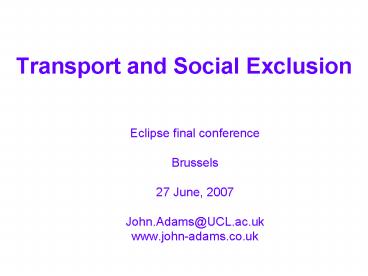Transport and Social Exclusion PowerPoint PPT Presentation
1 / 34
Title: Transport and Social Exclusion
1
Transport and Social Exclusion
- Eclipse final conference
- Brussels
- 27 June, 2007
- John.Adams_at_UCL.ac.uk
- www.john-adams.co.uk
2
ECLIPSE and its predecessor MATISSE, have
consolidated an increasing realisation across
Europe that, in the past, transport policies have
contributed to social exclusion. However,
transport policies, if properly integrated with
mainstream social policy, have the potential to
improve social inclusion and cohesion in Europes
cities and rural regions.
3
ECLIPSE and its predecessor MATISSE, have
consolidated an increasing realisation across
Europe that, in the past, transport policies have
contributed to social exclusion. However,
transport policies, if properly integrated with
mainstream social policy, have the potential to
improve social inclusion and cohesion in Europes
cities and rural regions.
4
(No Transcript)
5
(No Transcript)
6
(No Transcript)
7
(No Transcript)
8
(No Transcript)
9
(No Transcript)
10
On 6th June 1997 John Prescott said I will have
failed if in five years time there are not many
more people using public transport and far fewer
journeys by car. Its a tall order, but I urge
you to hold me to it"
On May 16 2007 John Prescott said I had never
envisaged we would have 7 million new cars. It
has created real problems.
Deputy Prime Minister and First Secretary of
State (until today)
Forecasts published by Prescotts department for
2007 at the time of his 1997 statement Motor
vehicles 27 6.85 million Traffic 35
8.9 million Growth of GDP over 10 years at 2.8
32
11
The number of passenger cars per 1 000
inhabitants is also often used as a way of
measuring the standard of living.
Eurostat http//epp.eurostat.ec.europa.eu/portal/
page?_pageid1996,39140985_dadportal_schemaPOR
TALscreendetailreflanguageenproductYearlies_
new_transportrootYearlies_new_transport/G/eba120
48
12
- London gt Edinburgh 332 miles
- Parking meters 20 apart
- Therefore 264 per mile
- One lane 87648 cars
- 7 million extra vehicles 80 lanes
13
Business as usualin Britain
- 5 miles per day in 1950
- More than 30 miles per day now
- 60 miles per day in 2025
14
(No Transcript)
15
(No Transcript)
16
- London gt Edinburgh 332 miles
- Parking meters 20 apart
- Therefore 264 per mile
- One lane 87648 cars
- 7 million extra vehicles 80 lanes
17
The social consequences of hypermobility (the
pollution-free perpetual-motion engine
electronic mobility too cheap to meter)
- more dispersed (more suburban sprawl)
- more polarised (greater disparity between rich
and poor)
- more anonymous and less convivial (fewer people
will know their neighbours)
- less child-friendly (childrens freedoms will be
further curtailed by parental fears)
- less culturally distinctive (the McCulture will
be further advanced)
- more dangerous for those not in cars (more metal
in motion)
- fatter and less fit (less exercise built into
daily routines)
- more crime ridden (less social cohesion and more
fear of crime)
- subject to a more Orwellian style of policing
(more CCTV surveillance)
- less trusting (the rise of the
audit/risk-assessment culture)
- less democratic (the majority will have less
influence over the decisions that govern their
lives)
18
The social consequences of hypermobility
- more dispersed (more suburban sprawl)
- more polarised (greater disparity between rich
and poor)
- more anonymous and less convivial (fewer people
will know their neighbours)
- more dangerous for those not in cars (more metal
in motion)
- less child-friendly (childrens freedoms will be
further curtailed by parental fears)
- less culturally distinctive (the McCulture will
be further advanced)
- fatter and less fit (less exercise built into
daily routines)
- more crime ridden (less social cohesion and more
fear of crime)
- subject to a more Orwellian style of policing
(more CCTV surveillance)
- less trusting (the rise of the
audit/risk-assessment culture)
- less democratic (the majority will have less
influence over the decisions that govern their
lives)
19
(No Transcript)
20
(No Transcript)
21
Department of Transport
22
Anonymity, more crime and fear of crime Big
Brother watches
23
CAUTION These plants are covered in sharp spikes
that may puncture the skin if touched DO NOT
HANDLE
The entrance to the Health and Safety Laboratory,
Buxton
24
No children
The swings are packed away at night because kids
might climb the fence and use them unsupervised
and hurt themselves.
25
(No Transcript)
26
Hypermobilitydemocracy
27
Three opinion polls
- Would you like a car and unlimited air miles?
- Would you like to live in the sort of world that
would result if everyones wish were granted? - Would you like to live in a cleaner, safer,
healthier, more sustainable world in which people
knew their neighbours, and it was safe for
children to play in the streets?
28
Ben Hamilton-Baillie
29
(No Transcript)
30
(No Transcript)
31
(No Transcript)
32
(No Transcript)
33
(No Transcript)
34
More Information
- OECD report on the social implications of
Environmentally Sustainable Transport - http//www.olis.oecd.org/olis/1999doc.nsf/63c71d2d
4054d0fdc125685d0053aee4/c125685b002f5004c125686b0
05cb510/FILE/00071363.PDFpage95 - a brief version of the report
- http//john-adams.co.uk/wp-content/uploads/2006/hy
permobilityforRSA.pdf . - A PowerPoint notes presentation
- http//john-adams.co.uk/wp-content/uploads/2006/Am
sterdam20hypermobility4.pdf

